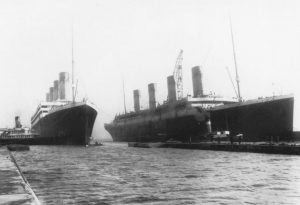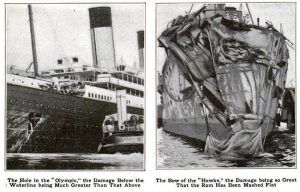The 15th of April 2012 marks the centenary of one of the most recorded events in recent maritime history, the sinking of RMS Titanic. While details have been more than adequately covered it is perhaps interesting to consider this ship was one of three sisters of the Olympic Class commissioned by the White Star Line intended to dominate the competitive North Atlantic passenger trade.
Olympic
Olympic was the lead ship and in common with her sisters built by Harland & Wolf at Belfast. At the time these were to be the largest ship’s afloat with their distinctive four tall funnels; she was 883 ft (269 m) long, 93 ft (28 m) beam and 35 ft (10.5 m) draught. She was 45,234 gross tons with her coal fired boilers providing steam to triple-expansion geared turbines giving a designed speed of 22 kts. Olympic was laid down on 16 December 1908, launched on 20 October 1910 and commenced her maiden voyage on 14 June 1911, a truly remarkable shipbuilding achievement.

Olympic in comparison with her sisters had an eventful and much longer life. In her first year of the cross Atlantic trade when leaving Southampton in September 1911 she was involved in a collision with the cruiser HMS Hawke with the armoured bow of the cruiser tearing a huge hole the relatively soft side of the liner. There were no injuries but she was taken out of service for two months for repairs. Following the loss of the Titanic in 1912 she was returned to Harland & Wolf for safety modifications. In October 1914 she went to the aid of one of the Royal Navy’s latest King George V battleships HMS Audacious which had struck a mine off the Irish coast laid by the minelayer Berlin; Olympic attempted to tow Audacious without success but managed to take off the majority of her crew, with only one casualty. Audacious with her smaller compartments and improved watertight integrity remained afloat for12 hours. The sinking of Audacious was withheld from the public until after the war. In 1915 Olympic became a troopship able to lift 6,000 troops per voyage; as a mark of respect she earned the nickname of ‘Old Reliable’. Adding to her wartime exploits in May 1918 she rammed and sank U-130 off the Cornish coast. In 1920 she was converted to oil burning. Her last hurrah was in 1934 when in fog she rammed and sank the Nantucket lightship with the tragic loss of eight lives. In 1935 she was withdrawn from service and sold to breakers.
Titanic
Titanic, slightly larger at 46,329 gross tons, was launched on 31 May 1911 and began her fateful maiden voyage on 10 April 1912 with 1,316 passengers and 892 crew. At 23:40 on 14 April she struck an iceberg with a glancing blow which tore a 300 ft gash spanning five of her 16 watertight compartments. In what were termed unsinkable ships their design called for them to remain afloat with any four compartments flooded. Although her total complement was 2,208, lifeboats were only available for 1,178 persons, which met then Board of Trade requirements. Titanic disappeared below the waves at 02:20 on 15 April when 1,503 passengers and crew died, there were 705 survivors. What remains of the wreck was discovered at the enormous depth of 3,800 m by Robert Ballard in 1985.

Britannic
The last of the sisters, again slightly larger at 48,158 gross tons, was launched on 25 February 1914 and was requisitioned by the Admiralty before completion. She was originally to be named Gigantic but as this too closely resembled that of her ill fated sister she was named Britannic. On 8 December 1915 she was commissioned as a hospital ship complete with 2,000 beds and painted in International Red Cross livery. A few days later on 12 December 1915 she made her maiden voyage to the Mediterranean returning with casualties from Gallipoli. She completed five successful voyages but on the sixth, with no casualties on board, on 21 November 1916 she struck a mine off the Greek Island of Kea, thought to have been laid by U-73, and despite modifications to prevent another Titanic sank in just under one hour. A contributing cause of the tragedy was thought to be lower port holes being left open by the nursing staff to ventilate wards in preparation for patients. This time with adequate lifeboats only 21 lives were lost. The wreck which remains relatively complete and undisturbed was first discovered by Jacques Cousteau in 1975.




